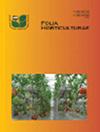Hot and cold drying of edible flowers affect metabolite patterns of extracts and decoctions
IF 1.8
4区 农林科学
Q2 HORTICULTURE
引用次数: 2
Abstract
ABSTRACT Edible flowers are rich in bioactive compounds and pigments that are on increasing demand in nutraceutical, medicinal, food, cosmetic and dyeing industries. This study evaluated the anthocyanins, phenolics and antioxidant activity of eight edible flowers (Bellis perennis L., Centaurea cyanus L., Dianthus carthusianorum L., Lavandula angustifolia Mill., Primula vulgaris Huds., Rosa canina L., Rosa pendulina L. and Viola odorata L.) after 24 h of hot drying (50 °C; natural convection stove) or cold drying (CD) (22 °C; heat-pump drying system). The hot-dried and cold-dried materials were then used to prepare ultrasound-assisted extracts, which are used as food additives or as a source of natural colourants, or decoctions (DECs), which are used for herbal teas. The edible flower UAEs and DECs had high amounts of anthocyanins (up to 3,284.6 mg C3G · 100 g-1), phenolics (up to 9,034 mg · 100 g-1) and antioxidant activity (866 μmol TE · g-1, 4,901 mmol Fe2+ · kg-1), with roses having the highest amount. The anthocyanin content and phenolic profile (flavonols, benzoic acids, cinnamic acids and flavanols) of edible flowers are found to be affected by drying and extraction methods. For decoctions, CD was found to be the most efficient drying method for all the parameters. For UAEs, CD resulted in a higher anthocyanin content, while hot drying resulted in a higher phenolic content, particularly flavanols. Overall, the studied edible flower extracts and decoctions can contribute to healthy and coloured substances, which can be used for designing innovative natural products. Rosa pendulina and R. canina are the most promising sources.食用花卉的冷热干燥会影响提取物和煎剂的代谢产物模式
摘要食用花卉富含生物活性化合物和色素,在营养、医药、食品、化妆品和染料行业的需求越来越大。本研究评价了8种可食用花卉(Bellis perennis L.、Centaurea cyanus L.、Dianthus cartusianorum L.、Lavandula angustifolia Mill.、Primula vulgaris Huds.、Rosa canina L.、Rosa pendulina L.和Viola odorata L.)在热干燥(50°C;自然对流炉)或冷干燥(CD)(22°C;热泵干燥系统)24小时后的花青素、酚类物质和抗氧化活性。然后,将热干燥和冷干燥的材料用于制备超声波辅助提取物,该提取物用作食品添加剂或天然着色剂的来源,或用于草药茶的煎剂(DEC)。食用花UAEs和DECs具有高含量的花青素(高达3284.6 mg C3G·100 g-1)、酚类物质(高达9034 mg·100 g-1)和抗氧化活性(866μmol TE·g-1,4901 mmol Fe2+·kg-1),其中玫瑰含量最高。食用花的花青素含量和酚类物质(黄酮醇、苯甲酸、肉桂酸和黄烷醇)受到干燥和提取方法的影响。对于煎剂,CD被发现是所有参数下最有效的干燥方法。对于UAE,CD导致较高的花青素含量,而热干燥导致较高的酚类含量,尤其是黄烷醇。总的来说,所研究的可食用花卉提取物和煎剂可以产生健康和着色的物质,可用于设计创新的天然产品。下垂蔷薇和犬齿蔷薇是最有前景的来源。
本文章由计算机程序翻译,如有差异,请以英文原文为准。
求助全文
约1分钟内获得全文
求助全文
来源期刊

Folia Horticulturae
Agricultural and Biological Sciences-Horticulture
CiteScore
3.40
自引率
0.00%
发文量
13
审稿时长
16 weeks
期刊介绍:
Folia Horticulturae is an international, scientific journal published in English. It covers a broad research spectrum of aspects related to horticultural science that are of interest to a wide scientific community and have an impact on progress in both basic and applied research carried out with the use of horticultural crops and their products. The journal’s aim is to disseminate recent findings and serve as a forum for presenting views as well as for discussing important problems and prospects of modern horticulture, particularly in relation to sustainable production of high yield and quality of horticultural products, including their impact on human health.
 求助内容:
求助内容: 应助结果提醒方式:
应助结果提醒方式:


